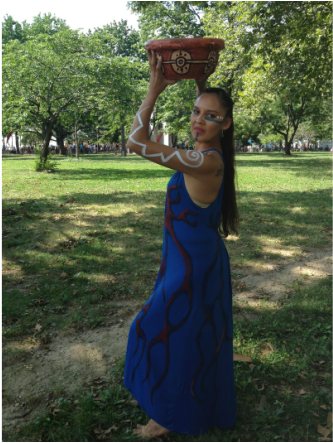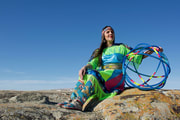Reflecting (on Dance): Dancing Earth brings “Walking at the Edge of Water” to New York City11/4/2013 In July- August 2013 I journeyed to the United States for my fourth time participating in a performance of Walking at the Edge of Water, choreographed by Rulan Tangen of Dancing Earth. We rehearsed in Santa Fe and performed two shows in New York City at the Downtown Dance Festival in Battery Park, sponsored by the Smithsonian Museum of the American Indian. There were ten dancers in the ensemble, and five of them I have worked with before (including Rulan) and it is always such an awesome experience to work with other Indigenous dancers. I would have to say this group is one of the best I have ever worked with, all being professional dancers, as well as, holders of traditional and spiritual knowledge and tradition. The way these dancers were brought together was nothing short of the universe flowing together in harmony. I believe we worked very well together and as a result were let out of rehearsal early on several occasions! (This in my experience is very rare) There were many instances where we came across signs that confirmed to us as a group and as individuals that we were meant to be here. We were destined to represent Indigenous dance next to dance companies from around the world, including NYC’s prestigious José Limón Company.
One of the first things we did upon arrival in NYC (after a red eye flight and a 6:00 am arrival) was visit the Two Row Wampum Gathering, which seeks honor for the original intention of the treaties, such as peace and sovereignty. The day before our arrival there was a march to the United Nations with hundreds of people who paddled canoes into NYC harbor in order to bring the message of the Two Row Wampum. The Two Row Wampum itself, which I had learnt about as a Graduate student with Dr. David Newhouse, represents two canoes paddling side by side along a river, neither interfering with the other’s vessel, but co-existing peacefully. This ideal had many implications and undertones relevant to our dance for the water. The river, canoes, peace and sovereignty is representative of many of the issues different Indigenous dancers have brought up over the years during the different explorations of Walking at the Edge of Water. When we arrived at the gathering we heard the Akwesasne Women Singers share a song for the water and the connection between women, birth and water. This is a theme we had heard from Anishnaabeg (Ojibway) women in Peterborough, Ontario during one of the first explorations creating dance around the theme of water. This was reflected for me in the fact that I was 15 weeks pregnant when we arrived in NYC, so my participation in Walking at the Edge of Water was especially compelling. In Anishnaabeg teachings water is also associated with emotions, such as those expressed through tears. I have been known to cry real tears on stage and backstage because of the emotional power in this dance. For me this was one of the most emotionally powerful performances of this show. Some of the Chiefs at the gathering spoke about the importance of water, and urged us to be aware of our impact on the water. An imminent and potent message as we sat next to the harbor where the canoes had paddled in and near the site where we would be dancing the next day to bring awareness to the issue. This was reflected in our performance through many images that depicted the harmful effects our actions have on water and the environment, such as oil, vanity, greed, and consumption. In a recent professional development opportunity, training in the’7 Habits of Highly Effective People’ we learnt about empathy. What we were taught was that reflecting is one of the highest forms of empathetic listening. The best way to show empathy towards others is reflecting back to them their words, thoughts and feelings. In this way we do not make assumptions, place judgement or focus on ourselves. We are simply reflecting what we hear or see. For me this resonated with my experiences in Walking at the Edge, of Water throughout this piece the dancers simply reflect... Reflecting water itself, reflecting Indigenous stories and teachings around water, reflecting how we all contribute to the destruction of water, reflecting the sacredness of water and the healing of water, thereby demonstrating the greatest form of empathy, one that makes no judgement or assumptions… And if the title of the training is accurate this is a ‘highly effective’ way to bring awareness to and show empathy for the sacred waters 'of our bodies and of the earth’ (as Rulan would say). We can only hope that this passion for the environment will continue to be reflected back to us through the people we meet, leaders that speak out, women that sing for the water, and is joined by the actions and voices of many more… Currently, I feel a great sense of pride as I follow Dancing Earth: Indigenous Contemporary Dance Creations on their tour to New Zealand, bringing this important dance and message to the world. You can read more about this journey at www.dancingearth.org or follow them on Facebook or Twitter. My participation was funded by the Canada Council for the Arts. Dancing Earth's U.S. dancers sponsored by the Smithsonian Museum of the American Indian in NYC.
2 Comments
|
Nehiawsko Pikiskwew'Cree Woman Speaking' is a space to share my voice. My goal is to spread awareness and share wisdom as I learn and grow as a dancer, choreographer, and woman. My passion is to show the healing power of dance and culture. I love learning from elders, experience, and research and being able to synthesize Native and non-Native ways of knowing! Archives
November 2023
Categories
All
|

